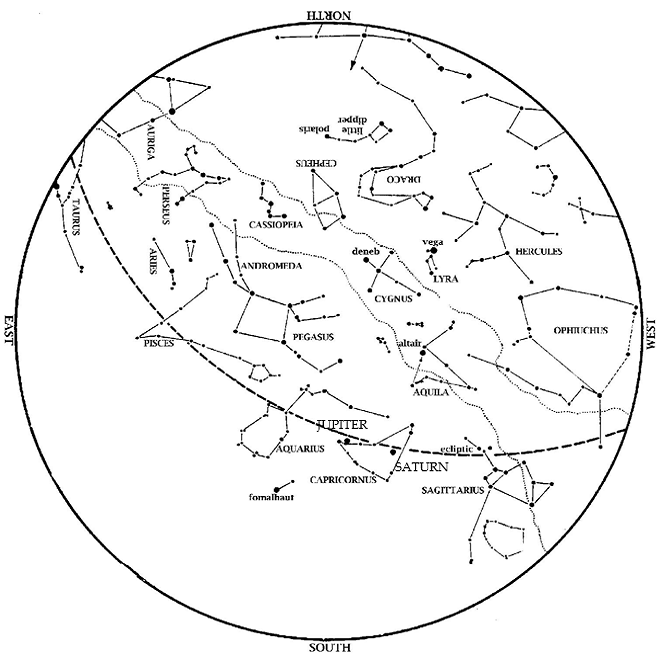Venus remains in the evening sky this month. Venus outshines everything except the Sun and the Moon, so it is unmistakably low in the southwest at dusk.
Jupiter and Saturn remain well placed for evening observing this fall. Look for Jupiter and Saturn in the south as night falls. Jupiter is brighter than all the stars we ever see at night. Saturn, to Jupiter’s right, is somewhat dimmer but still outshines all of the stars near it
Mars remains lost in the Sun’s glare this month and is thus not visible. In fact, Mars is behind the Sun (at conjunction) on October 7.

Autumn represents sort of an ‘intermission’ in the sky, with bright summer stars setting at dusk, while bright winter patterns such as Orion have not yet risen. The ‘teapot’ of Sagittarius sets in the southwest early in the evening. The Summer Triangle is high in the west. Meanwhile, the Great Square of Pegasus is in the east, indicating that autumn has begun. The stars rising in the east are much dimmer than those overhead and in the southwest because when you face east at dusk in October, you face out of the Milky Way plane. The center of our Galaxy lies between Scorpius and Sagittarius, while the Summer Triangle is also in the galactic plane. When we face Pegasus, on the other hand, we face out of the plane of our galaxy. Pegasus, then, is a good place to look for other galaxies. Nearby constellations Andromeda and Triangulum (a small triangle) contain the spiral galaxies nearest to our own.

The Summer Triangle is high in the west. The ‘teapot’ of Sagittarius sets in the southwest. Saturn and Jupiter are in the south at dusk, with the brighter Jupiter to the left of Saturn. The Great Square of Pegasus is high in the east at dusk. To the south and east, we see a vast dim area of sky known as the ‘Celestial Sea’, where only Fomalhaut stands out.
Moon Phases in October 2021:
New October 6, 6:05 a.m.
1st Quarter October 12, 10:25 p.m.
Full October 20, 9:57 a.m.
Last Quarter October 28, 3:05 p.m.
Our George Observatory is now open every Saturday night for observing! Purchase tickets in advance on our website.
Clear Skies!
Wishing you could rewind the night’s sky? Take a look back at September’s Sky Happenings.





